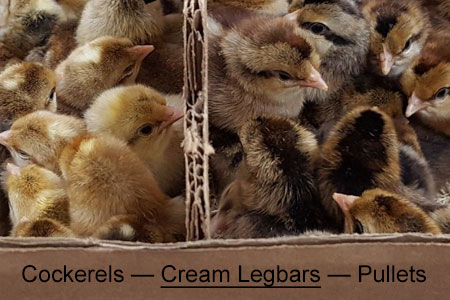
The terms “sex link” and “autosex” both refer to chicks whose gender is obvious as soon as they hatch. But the two terms are not synonymous. Sex link chickens, or sex links, result from mating a hen and a rooster of two different breeds. Autosex chickens are the offspring of a hen and a rooster of the same breed and variety. Let’s take a closer look at the differences between sex link and autosex chickens.
Why Is Sex Linkage Important?
The conventional approach to determining the sex of chicks requires a close-up look at their tiny sex organs. This technique, referred to as vent sexing, requires skilled professionals who sometimes make mistakes. In the case of both sex link and autosex chickens, obvious differences in their physical appearance reveal their gender.
What Is a Sex Link Chicken?
A sex link chicken utilizes both dominant and recessive genes, or the presence and absence of them. These genes are on the sex chromosomes of both parents, hence “sex link.” The variations can include down color or the length of wing feathers at hatch.
Red Sex Links for example, involve mating a Rhode Island Red rooster to a Delaware hen. In the resulting chicks, the females (pullets) are red, while the males (cockerels) are yellow.
The opposite mating does not produce sex links. If you were to cross a Delaware rooster with a Rhode Island Red hen, all the first-generation chicks, whether pullets or cockerels, would have the Delaware feather pattern.
What Is an Autosex Chicken?
The term autosex differentiates between sex link crossbreds (hybrids) and sex link straightbreds (purebred chickens). Like sex link chicks, the physical appearance of autosex chicks also reveal gender.
An example of an autosex breed is the barred Plymouth Rock. All the chicks are black with white spots on their heads. But the cockerels are a little lighter in color and their head spots tend to be irregular and elongated or scattered. The pullets, by contrast, are somewhat darker and their spots are more round and compact. Sexing chicks of such autosex breeds is not always as easy as sorting sex link hybrid chicks.
Examples of Autosex Chickens.
During the 1930s many autosex breeds arose with a focus on making a chicks’ gender easier to identify. These breeds were developed in Cambridge, England, using barred Plymouth Rock crosses.
The names of these new breeds combine the names of the primary crosses. The most popular of these autosex breeds is the cream Legbar, which involves crossing a barred Rock with a Leghorn, among other breeds. At hatch the cockerels have lighter down than the pullets. Some of those British autosex breeds either remain relatively rare or are now extinct.
Another autosex example is the Bielefelder from Germany. This breed, too, has a barred Plymouth Rock background. Pullets are dark brown, with chipmunk stripes that extend from the head down the back, and a black bar across their eyes. Cockerels are light brown with a white head patch.
In the United States the autosexing California Gray results from crossing barred Rocks with white Leghorns. The pullets are darker than cockerels. Today this breed is used primarily to produce the sex linked California White. Although all the chicks are yellow with black body spots, only the pullets have head spots.
What’s the Key Difference?
A key difference between sex link and autosex chickens is that sex link hybrids do not produce consistent offspring. In other words, they don’t breed true. With an autosex breed, on the other hand, every chick resembles its purebred parents.
Helpful Links
4 Outstanding Dual Purpose Sex Link Hybrid Chickens
Sex Link Chickens from Cackle Hatchery®
22 Autosex Breeds of Chickens and Geese
And that’s today’s news from the Cackle coop.
Gail Damerow has written numerous books about keeping poultry, many of them available from the Cackle Bookstore.

